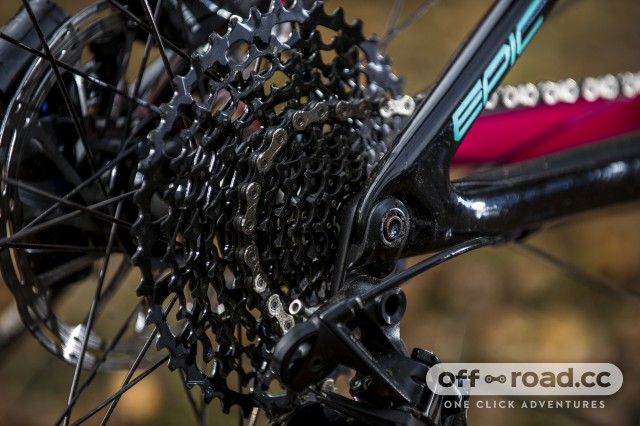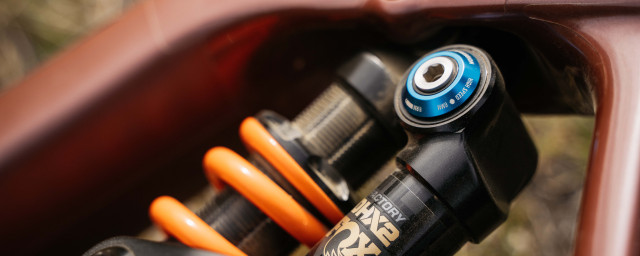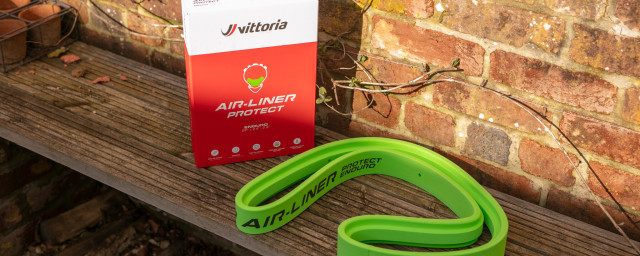
- The Brain system is very efficent
- Trail bike inspired geometry
- Brain Fade lever increases rider or race tunability
- Seat angle, effective top tube reach adjustments would enable the bike to be even more balanced
- Brain 'clunks' on activation
- Can't adjust Brain Fade setting whilst moving
The Specialized Women’s Epic Comp Carbon is a task master, a bike where nothing other than full speed will do. It will be your best training partner and likely podium companion, if you don’t mind the clunk in the 'Brain' shock and choose the right setting for the race conditions too.
- Review: Cube Reaction GTC One - high value, high-speed carbon race hardtail
- When should you replace your bicycle helmet? We asked the experts
- Review: Trek Roscoe 9 - playful fat tyred trail hardtail
Specialized make no bones about it; the Epic is a race machine born and bred, and with a massive number of cross-country wins under their belts they are clearly doing something right. Not content with sitting on their laurels, the big ‘S’ have completely redesigned the Epic for 2018. It's a hell of a lot lighter, the suspension layout now boasts a single pivot design rather than the usual four-bar linkage and they have updated both the location and the inner workings of ‘The Brain’ –an inertia valve that automatically adjusts the damping of the rear shock.
One of the biggest changes for the 2018 Epic is the removal of the chainstay pivot, moving the bike away from its previous FSR (Horst) link and taking it into the realms of a single pivot design. Why? Well, Spesh say they have saved 240g, made the rear end stiffer, and improved power transfer. Using flex zones in the chain and seat stays they say they can emulate the performance of the FSR system and in turn were able to tune the ride to perform better under pedalling forces.
Secondly, the bike has been on a diet, losing 525g from the frame alone Each size features different carbon layups and tube shapes unique to it, allowing the engineers to set a specific ride quality so you’ll get the same ride feel across the board.
The Brain, explained
The Brain technology has been in play on the Epic for 15 years but this year it has been altered significantly, beginning with a collaboration with Rockshox rather than Fox. The Brain is an inertia valve system so it knows the difference between inputs from the trail and the cockpit, leaving Specialized able to tune the shock (and forks as on the pricier models) to have a firmer compression damping value for the rider inputs compared to those coming from the trail. In short, the suspension is firm to rider pedalling inputs and then reacts to bumps in the trail transmitted upwards through the rear wheel by opening up.
The Brain reservoir is now located just behind the axle, as this is where the moment of inertia occurs and means it can react more quickly. When the reservoir moves, the brass mass inside the Brain lags behind, exposing the main oil flow port which allows oil to move and compress the shock. Conversely, it will hold the valve closed until a large enough bump is felt upwards from the rear wheel, whereupon it moves, allowing the full range of travel.
Internal changes for 2018 include the use of a bladder rather than an internal floating piston (IFP) to separate the pressurized nitrogen chamber from the damping oil. This bladder does the same job as the IFP, keeping oil flowing properly and preventing cavitation, but without the internal friction inherent with the former design. It also transitions from compression to rebound faster, meaning there is less stiction and heat generated on the side of the chamber. Damping has been improved too, say Specialized, as an updated Spike Valve creates a regressive damping curve for improved ride quality when it gets really rough.
That brings us on nicely to the introduction of a ‘Brain Fade’ lever that enables you to change the reaction of the Brain through five different settings. The lever turns a shaft which turns a plate with a large kidney shaped hole in it over smaller ports. In Firm (closed) mode, the plate is completely covering all ports. With each click the lever, it uncovers one small hole per click and allows more oil flow. ride the Epic with the Brain in Firm and pedal efficiency will be at its utmost. However, in all but the open setting, I felt a ‘clunk’ as the internals reacted to input from the rear wheel. Take the lever through to the other settings and although the bike will pedal marginally less efficiently, it provides a smoother ride, soaking up bumps and providing lots of rear wheel traction.
The Spec
Our test bike is the women's Comp Carbon model, it’s got 100mm of travel front and rear and comes in at £3,500. For that, you get a carbon frame and rear triangle, Rockshox Reba RL forks, Rockshox Brain shock, 1x11 SRAM GX with Race Face Aeffect crankset and SRAM Level TL brakes. Everything else is Specialized born and bred kit; Roval Control 29er (22mm internal width) rims, Fast Trak 2.3” tyres, and on our women’s bike; 720mm handlebars and a Specialized Myth Sport saddle.
Crucially the women’s version of the bike also comes with a different shock tune, meaning the compression and rebound of the shock have a lighter tune. Here Specialized think that female riders won’t weigh as much as their male counterparts and might not ride as hard. I didn’t find that I blew through all the travel, which I might have if the shock tune was too light for me and I managed to find a rebound setting that worked for my riding, so Spesh seemed to have the tune dialled here. We weighed our medium test bike as it came out of the box, sans pedals but including the supplied bottle cage and multitool, at a hair's breadth over 25lbs (11.33kg).
Riding or racing?
Get on the Epic and it will goad you to go faster and faster at every given uphill opportunity. It's an accomplished climber; the low weight and the relatively long 438mm chainstays at see to that. The seat angle isn’t too bad either, but steepening it even further from the 74.75 degrees combined with lengthening that top tube a bit would improve the Epic’s climbing ability further, putting the rider's weight further forwards and helping to keep the front end on the ground during technical climbs.
A steeper seat angle, a longer effective top tube and therefore reach would lengthen the wheelbase enabling the bike to be more balanced both on technical climbs and when riding downhill too. It’s fair to note at this point thought that if this bike were to be used for marathon type races then a steeper seat angle could place too much weight on the hands on the flat and cause fatigue but this could be balanced out by the bike's increased performance uphill.
When pointing this thing in the downhill direction its clear that Specialized has made an effort to make this little bike feel more like a trail bike than an all-out racer, which I think is a good thing. The Epic’s head angle has been slackened to 69.5°, a whole degree and a half slacker than last year and they could still certainly loose another degree without causing any detriment to the bike’s handling. A slacker head angle would increase the length of the wheelbase and increase the bikes stability downhill.
Yes, it might take more steering input to ride but I think the consequences of this are negligible compared to the advantages it could bring in technical trail sections. The bottom bracket isn’t the lowest but at a height of 332mm it goes some way to give the bike that ‘trail bike feel’. Interestingly Specialized have shortened the offset of the fork on this bike, it’s now 42mm rather the 51mm usually seen on a 29er. The effect of this is to increase the ‘trail’ of the fork, which although it shortens the wheelbase, it slows the steering and increases the stability of the bike, making it easier for the rider to weight the front wheel, all adding up to a less twitchy feeling on the trail.
On undulating terrain the Brain does its job admirably, there’s very little lag between the valves opening for a big hit and closing again for pedal efficiency. Diving down into a bomb hole and then pedalling out the other side it didn’t take long for the suspension to realise the change and prevent the shock from bobbing. The ride isn’t plush by any means but then it’s not supposed to be - there’s plenty of trail feedback both through the hands and the feet as the suspension skips over the terrain.
I found leaving the Brain Fade lever in one step less than open was the sweet spot; here it’ll let the rear wheel grip up chunky climbs and be ready for the descents without too much of the clunkiness I mentioned above.You'll need to choose your setting before the race though and be prepared to stick with it, the lever is on the Brain resevoir at the rear of the bike and would mean stopping to adjust. Traction can only be improved by swapping out the lightweight FastTrak tyres for something a bit more UK appropriate, I opted for a Specialized Purgatory for the front and Ground Control at the rear.
If you are looking for a full suspension cross country bike then you could do a whole lot worse than go for a Spesh Epic. It’s a competent bike and the £3,500 price tag is the going rate for a full-suss, race ready machine unless you purchase from a direct sale brand, though this bike will need a couple of tyre and dropper post upgrades before heading out for more trail-focused riding. The women’s version of the Carbon Comp Epic is one beautiful beast, the colour is a turn on for me but if it’s not your thing then the geometry of the men’s version is exactly the same so you can always put your money that way instead.

















Add comment